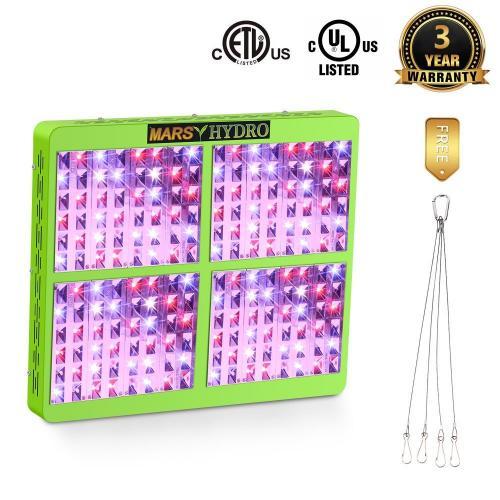LED grow lights are sometimes compared by looking at what has been called, true wattage, actual watts or even draw from the wall. This post looks at what these terms are and why they are misleading when comparing LED grow lights. This post is adapted from Feed The Seeds.
Understanding Watts
Watts are a measure of power. Electricity can be measured with three different metrics: voltage (V), current (I), and resistance (R).
Voltage measures the difference in electrical charge between two contacts. Current measures the rate of flow, and resistance measures the amount of current a circuit can handle. Voltage is equal to the total current multiplied by the resistance, V = I x R.
You can think of this like water flowing through a hose. Resistance is the size of the hose, current is the volume of water flowing through it, and voltage is the pressure of the water. Imagine that you have two hoses, one large and one small. If you were to push one liter through both of these hoses over the course of 60 seconds, they would each flow a little differently. In the small hose, the water would flow quickly and come out at high pressure. In the large hose, the water would be low pressure and have a more gradual flow.
Watts are equal to the current multiplied by the voltage, W = I X V. In this analogy, watts are a measure of both the quantity of water and the pressure. We often think of wattage as a simple measure of the volume of electricity used, confusing it with units used in a household (Watt.hours). Watts measure both the quantity of electricity and the amount of strain being applied to the circuit.
True wattage or Draw From the Wall
True wattage is the measurement you’ll want to know to determine the actual power usage of your grow light. The actual power used by both the electrical circuits and the lights themselves – fans, etc. – are referred to as true wattage. Although true wattage is a good measure of power draw, it is not a good measure of light output because you have no idea how efficient the system is. The only true and useful measure of light output with grow lights is PPFD.
LED Wattage
LED wattage is the measurement of the maximum potential power that your LEDs can handle. A light with 100 LEDs each rated at 3 watts, would have an LED wattage of 300. LED wattage is a theoretical maximum and LEDs are almost never pushed this hard in practice. Running LEDs at their maximum potential power, generate more heat and tend to burn out quickly. Therfore, LED grow lights supply less than the maximum power to the LEDs, ensuring they are more efficient.

The perfect example of this is the Mars-Hydro Reflector LED grow light. The first generation of this product used 3 watt LEDs and ran them at full power. Once consumers reported problems with lights dying after only a few years, they replaced all the LEDs with 5-watt versions. The LED wattage rating for the Reflector 192 went from 576 (192 x 3) watts to 960 (192 x 5) watts. However, because they are running these LEDs at less than their capacity, the true wattage rating remained the same. Running the diodes below the theoretical maximum allows Mars-Hydro to offer an amazing 3 year warranty, fulfilled in South Africa.
Equivalent Wattage or HPS Equivalent
Probably the most misunderstood power rating in the industry. LED grow lights were not well received when they first appeared. LEDs usually produce more light per watt than other types of lighting and this was not very well known. Consumers would see a 250 watt LED light for the same price as a 500-watt HPS light, and assume that the HPS was twice as powerful. For this reason, manufacturers advertise equivalent wattage. When you’re told that an LED light has an equivalent wattage of 500, they’re saying that you would need to purchase a 500 W HPS light to produce the same quantity of light.
Using True Wattage and Other Power Ratings
Each of the ratings mentioned above can tell you a little bit about the grow light you are about to purchase. The most important rating is true wattage. A setup that draws 1 000 watts of power uses 1 unit (kWh) of electricity per hour.
LED wattage can, in some cases, help you estimate longevity. For example, let’s say that you are choosing between two cheap LED grow lights. One requires 330 watts of power and the LEDs are rated at 300w. The other requires the same 330 watts of power, but the LEDs are rated at 500 watts. It’s clear that the first one is operating their LEDs at their maximum. This means that you’ll likely generate more heat, and the lights will not last as long. If you’re purchasing a high-end grow light, you don’t want to worry about this value quite as much. With high-quality components and careful engineering, LEDs can run at or near their peak performance without degradation.
In most cases, equivalent wattage is simply a marketing trick that allows manufacturers too put big, impressive numbers on their packaging. However, there are two ways you can use this value. There is a little correlation between light output and equivalent power draw, so this can be a quick way to narrow down your choices of LED grow lights. If you’re upgrading your HPS growing system, then this value can help you understand which lights will be a suitable replacement. This rating is always a rough estimate. Every manufacturer calculates it differently. At the end of the day, you’ll want to make sure you are using the correct metrics to measure the output of your lights. The correct metrics are PAR and PPFD.
